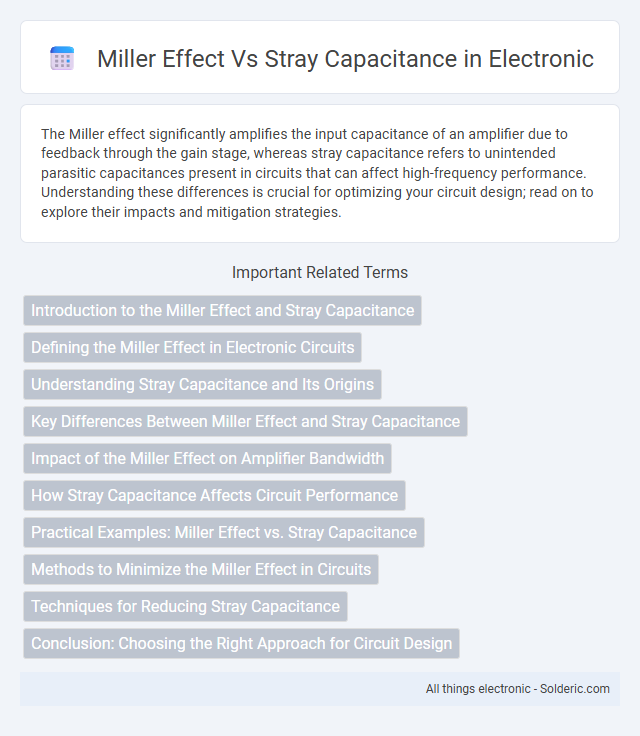The Miller effect significantly amplifies the input capacitance of an amplifier due to feedback through the gain stage, whereas stray capacitance refers to unintended parasitic capacitances present in circuits that can affect high-frequency performance. Understanding these differences is crucial for optimizing your circuit design; read on to explore their impacts and mitigation strategies.
Comparison Table
| Aspect | Miller Effect | Stray Capacitance |
|---|---|---|
| Definition | Increase in effective input or output capacitance due to amplification across an inverting gain element | Unintended parasitic capacitance between circuit nodes and ground or adjacent components |
| Cause | Voltage gain in amplifiers causing feedback through internal capacitances | Physical layout, component leads, PCB traces, and proximity of conductive elements |
| Effect on Circuit | Reduces bandwidth by increasing input or output capacitance | Leads to signal distortion, noise, and undesired coupling |
| Typical Locations | Amplifier input-output nodes, transistor capacitances (e.g., Miller capacitance) | PCB traces, component leads, connectors, solder joints |
| Mitigation | Use of cascode stages, neutralization techniques, buffer amplifiers | Optimized PCB layout, shielding, guarding, component spacing |
| Significance | Predominant in high-gain, high-frequency amplifier designs | Relevant across all circuits, especially high-frequency and sensitive analog designs |
Introduction to the Miller Effect and Stray Capacitance
The Miller Effect occurs when an amplified voltage difference appears across a feedback capacitor, significantly increasing the effective input capacitance in amplifiers, which can limit high-frequency performance. Stray capacitance refers to unintended parasitic capacitances present between nearby conductive parts in a circuit, often causing signal integrity problems and bandwidth reduction. Understanding how the Miller Effect amplifies the impact of stray capacitance helps you design circuits with improved frequency response and stability.
Defining the Miller Effect in Electronic Circuits
The Miller Effect in electronic circuits refers to the apparent increase in input capacitance due to the amplification of an inverting amplifier stage, which multiplies the feedback capacitance between its input and output terminals. This phenomenon can significantly impact high-frequency performance by creating a larger effective capacitance that slows signal transitions. Your circuit's bandwidth and stability may be compromised if the Miller Effect overshadows stray capacitance, which is the unintended and usually smaller parasitic capacitance present between circuit elements.
Understanding Stray Capacitance and Its Origins
Stray capacitance arises from unintended capacitive coupling between circuit elements, typically caused by the physical layout and proximity of conductive parts. It originates from parasitic capacitances between wires, PCB traces, and components, influencing high-frequency behavior by introducing signal distortion or crosstalk. The Miller effect amplifies the impact of certain parasitic capacitances, especially in amplifiers, by reflecting input-output capacitance and increasing the effective input capacitance seen by the source.
Key Differences Between Miller Effect and Stray Capacitance
The key differences between the Miller effect and stray capacitance lie in their origins and impacts on circuit behavior. The Miller effect refers to the apparent increase of input capacitance caused by feedback through an amplifying element, significantly impacting high-frequency response and gain bandwidth in amplifiers. In contrast, stray capacitance is unintended parasitic capacitance resulting from physical proximity of circuit elements, causing signal coupling and noise but not inherently tied to amplification or feedback mechanisms.
Impact of the Miller Effect on Amplifier Bandwidth
The Miller effect significantly increases the effective input capacitance of an amplifier, thus reducing its bandwidth by creating a larger capacitive load at the input. This phenomenon amplifies the impact of stray capacitance, worsening high-frequency performance and limiting the amplifier's frequency response. Designers often counteract the Miller effect using techniques like neutralization or cascode configurations to maintain wider bandwidth.
How Stray Capacitance Affects Circuit Performance
Stray capacitance introduces unintended capacitive coupling between circuit elements, which can degrade signal integrity and reduce overall circuit performance. This parasitic effect increases input capacitance, leading to slower response times and potential instability, especially in high-frequency or high-gain amplifier circuits affected by the Miller effect. Understanding and minimizing stray capacitance in your design is crucial for maintaining signal clarity and optimizing circuit speed.
Practical Examples: Miller Effect vs. Stray Capacitance
In amplifier circuits, the Miller effect significantly increases the effective input capacitance due to feedback through the gain stage, drastically reducing high-frequency performance as seen in common-emitter amplifiers. Stray capacitance, caused by parasitic elements like PCB traces and component leads, introduces unintended coupling between nodes, often degrading signal integrity in high-speed digital and RF circuits. Practical examples include Miller effect limiting bandwidth in voltage gain stages, while stray capacitance can cause crosstalk and ringing in densely packed high-frequency PCB layouts.
Methods to Minimize the Miller Effect in Circuits
Minimizing the Miller effect in circuits involves techniques such as using cascode configurations to reduce the effective input capacitance and deploying buffer stages to isolate the input from the voltage gain. Additionally, low input impedance designs and neutralization methods can significantly decrease the impact of the Miller capacitance on high-frequency performance. Employing these strategies helps enhance your circuit's bandwidth and stability by mitigating the dominance of parasitic capacitances caused by the Miller effect.
Techniques for Reducing Stray Capacitance
Reducing stray capacitance involves techniques such as minimizing lead length, using shielded cables, and optimizing PCB layout to reduce parasitic capacitance effects. Implementing guard rings and ground planes further isolates sensitive circuit nodes from unwanted capacitive coupling. These methods help mitigate the Miller effect by limiting the total capacitance seen at critical transistor terminals, improving high-frequency performance.
Conclusion: Choosing the Right Approach for Circuit Design
Selecting the appropriate method between addressing the Miller effect or stray capacitance depends on the circuit's frequency range and performance requirements. Miller effect compensation is crucial in high-gain amplifiers to minimize bandwidth reduction, while mitigating stray capacitance is essential for maintaining signal integrity in high-frequency or high-speed circuits. Understanding these phenomena allows engineers to optimize circuit stability, speed, and overall efficiency effectively.
miller effect vs stray capacitance Infographic

 solderic.com
solderic.com